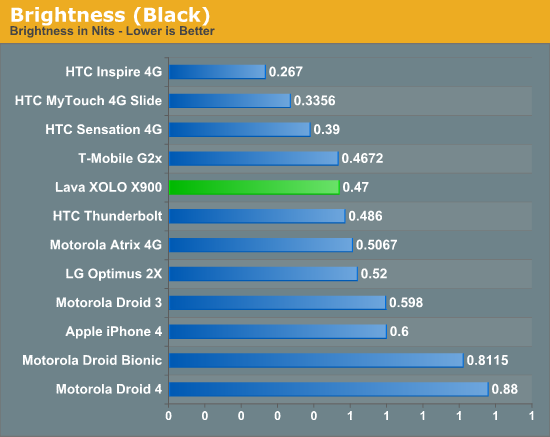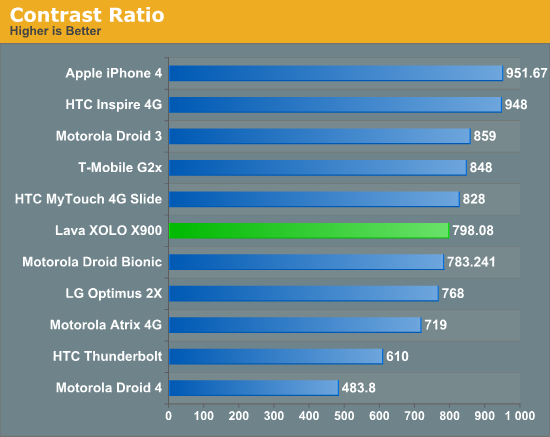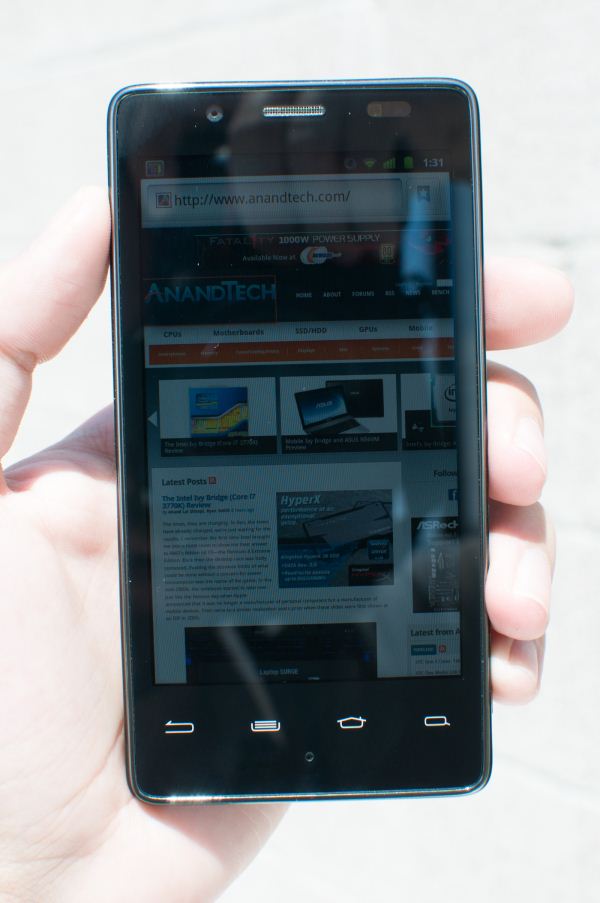Lava Xolo X900 Review - The First Intel Medfield Phone
by Brian Klug on April 25, 2012 6:00 AM ESTDisplay
I mentioned earlier that it’s interesting that Qualcomm, Intel, and others have identified and gone with WSVGA (1024x600) for their reference designs at around 4“. In the case of the FFRD/X900, it’s 4.03” WSVGA TFT-LCD. That works out to 295 PPI and looks extremely attractive in person. I find it quite hard to pick out individual pixels; this is definitely a high PPI display that’s right up there with the best. In addition, the capacitive digitizer is excellent; I have no complaints about tracking accuracy at all, again just like you’d expect from a shipping device.



The X900 also goes pretty bright, at 375 nits, and has good contrast at around 800. I’m impressed with the display again just because up until recently seeing good LCDs outside of anything but the iPhone 4/4S has been a rarity. The HTC One X and Rezound are probably the only other devices in recent memory that surpass, but suffice it to say Intel/Lava haven’t skimped here.
As you can see from the gallery above, the display's performance is pretty good. CIE shows primaries and secondaries are close to where they should be, but not perfect (but way better than AMOLED insanity). Unfortunately color temperature is around 7500K constantly, and gamma is a bit sporadic. It’s worth dealing with those inconsistencies for that high PPI though.
Outdoor viewing angles are also pretty good, basically what we're used to for LCD displays outside in direct sunlight.

















106 Comments
View All Comments
superPC - Thursday, April 26, 2012 - link
Well this atom only has 1/4 of conroe dual core transistor count right now. a move to 22nm could bring conroe level performance.Khato - Thursday, April 26, 2012 - link
Remember, conroe class performance simply indicates a general IPC level. I don't expect something on par with an E8600, more like a SU9600. It's quite feasible on the 22nm LP process, and actually is roughly in-line with the one Atom performance roadmap from awhile ago.extide - Wednesday, April 25, 2012 - link
That wont be happening for a while, but from what I have heard 2013 will bring us a second gen (out-of-order) atom on a mature 22nm process. We should see 2Ghz+ clockspeeds and 2 cores, plus a healthy IPC boost. This is going to be an exciting battle to watch, the old Intel vs AMD gig is kind of stale, so its awesome to see a real challenge for Intel again!A5 - Wednesday, April 25, 2012 - link
ULV Haswell will have a TDP an order of magnitude too high for a phone form factor. Tablets, maybe.MonkeyPaw - Wednesday, April 25, 2012 - link
"We waited years for Intel's first smartphone, now the question is how long do we have to wait for the first irresistable one?"It wont matter. Intel will dump millions into advertising, and every single phone maker will have ads for their new x86 phones, ending with the usual Intel chorus.
dougys - Wednesday, April 25, 2012 - link
I read somewhere else a few weeks back that the iPhone 5 could have Intel Inside. However, something else I read suggested that if they were to do this all the apps would have to be re-written... Does anyone have any thoughts/insight?tipoo - Wednesday, April 25, 2012 - link
Apple has a few architecture changes under its belt, but I very much doubt it, not for this chip. Apple bought chip design companies and spends more on internal chip design year after year for good reason.Not sure about iOS compatibility but this chip can run any Android apps just fine as the article points out through binary translation, I think Android apps use Java and iOS uses C++ though so I'm not sure if that would still work.
If Apple was to go to an outside design for its chips (which I highly doubt it will) I'd hope it would be for Qualcomm, Krait is amazing.
dcollins - Wednesday, April 25, 2012 - link
Apple will not move to an Intel chip anytime soon because they have been very successful in designing their own SoC. Just look at the battery life benchmarks: Apple crushes everyone in Hours/Watt*Hour. Plus, doing it in house gives them more flexibility on the overall design of their boards.There is a small chance of Intel manufacturing chips for Apple, but that is a long shot as well. Chips manufactured on Intel's 22nm 3d gate process would be incompatible with chips produced on competing 28nm processes (different physical size) and Apple is traditionally opposed to single sourcing crucial components.
tipoo - Wednesday, April 25, 2012 - link
Why does the GN get worse flash performance than the Nexus S and even Nexus One? That isn't a resolution dependant test, right?I'm also curious why the dual core Atrix barely does better than the single core Nexus S in Vellamo, was that just a bad SoC design or is it because it runs an older OS?
tipoo - Wednesday, April 25, 2012 - link
I also just got 915 on my Nexus S rather than 622, but I'm using an unofficial Cyanogenmod 9 build from XDA forums.